Family Feud 1st Fast Money 200 Points One Turn
| Hosts | |
| Richard Dawson (1976–1985, 1994-1995) Ray Combs (1987–1994) Louie Anderson (1999–2002) Richard Karn (2002–2006) Ricki Lake (Gameshow Marathon, 2006) John O'Hurley (2006–2010) Al Roker (2008 primetime) Steve Harvey (2010–Nowadays) | |
| Announcers | |
| Johnny Olson (1975) Factor Forest (1976–1995) Rod Roddy (sub) Johnny Gilbert (sub) Art James (sub) Burton Richardson (1999–2010, 2008–Present primetime) Rich Fields (Gameshow Marathon, 2006) Joey Fatone (2010–2015) Rubin Ervin (2015–Nowadays) | |
| Broadcast | |
| Syndication: 9/19/1977 – 5/17/1985 | |
| Packagers | |
| Mark Goodson-Bill Todman Productions (1975–1982) Marking Goodson Productions (1982-1995) Pearson Television receiver (1999-2002) (Fremantle) Media North America (2002-Nowadays) | |
| Sub-Packagers | |
| The (New) Family Visitor (1976–1994) Feudin' Productions, Inc. (1999–2010) Wanderlust Productions, Inc. (2010–Present) Georgia Entertainment Industries (2011–2018, 2020-Present) Triple Threat Productions (2015–Nowadays) | |
| Distributors | |
| Viacom Enterprises (1977–1985) LBS Communications (1988–1992) All American Television (1992–1995) Pearson Television (1999-2001) Tribune Entertainment (2001–2007) Debmar-Mercury (2007–Present) 20th Goggle box (2007-2019, Ad Sales) CBS Television Distribution (2019-Present, Ad Sales) | |
Family Feud is a spin-off from Match Game's big money "Super Match" bonus circular. This show is where ii families boxing information technology out by answering surveys to win points/dollars. The starting time to reach a set number of points/dollars (originally 200 in the pilot and first season, and so 300, and 400 during Dawson's 1984-85 flavor and their "Tournament of Champions" episode) gets a take a chance to play Fast Coin for a g cash prize. Each family has 5 members per team (10 in total), except from 1994 to 1995, when in that location were only 4 members per team (eight in total). During the one-hour versions from 1992 to 1995, two new families competed in the first half-hour for the right to face the champions in the second one-half. Early in Dawson's season, the winners of the first one-half competed in the second half against a family from the original Dawson era in 1994.
Since its inception in the 70s, the show had a share of a few culling titles as well:
- All-Star Family Feud Special (featuring celebrities playing for their favorite charities)
- Family Feud Challenge (CBS daytime version of the show from 1992-1994 which features the Bullseye circular)
- The New Family Feud (1992-1994 syndicated version of the show that too features the Bullseye round)
- Celebrity Family Feud (similar to the "All-Star" Primetime specials from the '70s)
Contents
- 1 Gameplay
- 1.i Chief Game
- one.1.ane Confront-Off
- 1.1.two Principal Question
- 1.1.3 Question Values
- 1.1.4 Winning
- 1.1.v Lollipop Tree (Dawson '76 version only)
- 1.ane.5.one Lollipop Tree Knockdown
- one.two Bullseye/Bankroll Round & Sudden Expiry Question
- 1.2.one Scoring
- 1.3 Bonus Round: Fast Money
- 1.iii.one Extra Notes
- 1.three.2 Grand Cash Prizes
- ane.3.iii Bullseye/Bankroll
- one.four Returning Champions
- 1.i Chief Game
- 2 The Uproar/Family Circle Survey (Anderson era simply)
- 3 Impaired Answer of the Mean solar day (Anderson era Only)
- 4 1992 Bullseye Pilot (Combs version Only)
- iv.1 Commencement Half
- four.1.1 Screenshots
- iv.2 Second Half
- iv.two.i Screenshots
- iv.1 Commencement Half
- five All-Star/Gameshow Marathon/Celebrity Family Feud primetime specials
- vi Tournament of Champions
- 6.1 1988–1994
- 6.two 2002–Present
- 7 Galleries
- 8 Additional Pages
- nine Sounds
- ten Spin-Offs
- eleven Inventors
- 12 Music
- 12.ane Chief Cues
- 12.2 Special Cues
- xiii Studios
- 14 1-900-230-FEUD (1989)
- 15 1997 Proposal
- 16 Family Feud Live!
- 16.1 Promo
- 17 Buzzr Version
- 18 International Versions
- 18.i Boosted Notes
- nineteen Trivia
- 20 Age Requirements
- 21 Ratings
- 22 Rebroadcasts
- 23 References
- 24 Links
- 24.one YouTube Videos
- 24.1.1 Family Feud Live!
- 24.one YouTube Videos
Gameplay [ ]
In each case, a survey of 100 people was taken for each question. (In a few cases, a specific grouping, such as 100 men, women, kids, etc. was surveyed; otherwise, the survey was of 100 random people). Whatsoever response that appears as an answer to that question had to be given by at least ii people (answers given by only one person were discarded).
Main Game [ ]
Face-Off [ ]
At the beginning of each round, i member of each family unit comes up to the chief podium to play a mini-circular for command of the question called "Face-Off". In the airplane pilot episode, only the team helm played each Face-Off; ever since, play continues down the line for each family, with the 2d players facing off for Question two, the third players for Question 3, and so on.
The host announces how many answers are on the lath (which are always in order based on popularity), and so reads a survey question and the first player to buzz-in gets to respond. The player to give the number one answer or have their respond be higher than the other player'southward answer wins control. In case of a tie (both answers with the same number of people who gave it) the player who answers beginning wins control. If neither role player answers to the board, the players at the primary podiums get a chance to respond for control.
For time reasons, during Louie Anderson's & the commencement season of Steve Harvey'southward tenure, if neither histrion's reply was on the board the question was thrown out and edited out of the episode, and a new one was played.
During Dawson's offset version & the current version, the thespian that won the Face-Off has a decision to either let his/her family play the question or laissez passer the question to other family opponents.
In the Harvey version, if the contestant buzzes in while he's reading the question, he would terminate reading the question immediately. He will then cease the question to the other family unit.
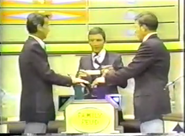
"Face Off" in progress from the pilot episode in 1975.
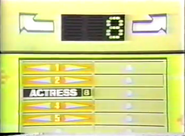
This respond is worth $8.
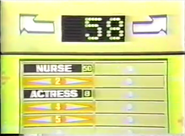
Number one answer, worth $50. Whoever answered tin can either let his/her family play the question or laissez passer it to other family opponents.
Main Question [ ]
The family unit that won the face-off earns command of the question. The decision-making family'southward job is to reveal the remaining answers hidden on the lath with each correct reply adding points to the bank in a higher place the board. The answer's value is adamant past how many people who gave it. Each player on the controlling team, in turn, gives an respond and if the answer he/she gives is correct, it is flipped over and revealed. Revealing all the answers on the board wins the circular (this is classified as a "Clean Sweep"). Giving a incorrect answer at whatsoever time earns a strike; getting 3 strikes (1 in the final round from 1999 to 2003) causes the squad to lose command of the question, giving the opposing family unit a chance to steal by giving i correct respond. A successful steal wins the circular, but an unsuccessful steal gives the round to the first family. The winners of the circular have all the points in the banking company plus (in the pilot, from 1992 to 1995, and again from 1999 to 2003) the value of the correct answer given by the stealing family. After that, the host volition reveal the remaining answers if there's anything left on the Survey board starting from the pinnacle to the lesser. Since Steve Harvey's 2nd flavour, the remaining answers are revealed from bottom to summit (ala Family Fortunes style).
In the Ray Combs era'southward later years, whichever team member caused the family to get a strike would have to concur a sign that consisted of a black stick with a white card with the Strike Indicator on it.
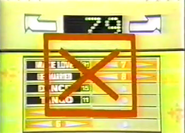
Strike one…
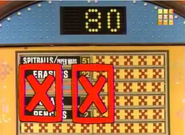
…strike ii…
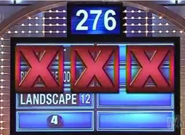
…strike three, now the other family unit opponents can steal all the points.
Question Values [ ]
On the 1975 airplane pilot, all questions scored their regular value. The first few questions have their values be worth the number showing. Subsequently on in the game, the values of all the questions doubled (the double value round wasn't available from 1999 to 2003); and nonetheless later, all the point values are tripled (in the Dawson era and the first 4 years of the current version, the triple valued question would be the final question of the game).
Winning [ ]
The first family to accomplish a set number of points wins the game. For most versions, the goal is 300 dollars/points. For the 1975 pilot, the first seventeen episodes of the 1977–1985 syndicated version, and the ABC daytime show through March 2, 1979, the goal was $200. From December 1984 to the 1985 finale, the goal was set up to $400 on both versions. Beginning in 1981, each family would be guaranteed a "house minimum" of $100 which would be increased to $250 in tardily 1982. The $250 guarantee would conduct over to the CBS revival in 1988.
In the original Dawson version and the 1994–1995 season, when the game took too long to reach the $300/$400 goals, he would get to the controlling family unit and tell them that each teammate had 3 seconds to answer in one case he read the question to them. Similarly, kickoff in 2003 (when the 300-point goal was restored), Karn only read the question one time to both families upon getting to the Triple round. In later episodes of Karn's final flavor (2005-06), whenever he read the question once, habitation viewers were shown the survey question at the bottom of the screen (too in a similar style to the British version of the Feud called Family Fortunes, when in the face-off from the main round, the question appeared at the bottom of the screen while the host reads a question).
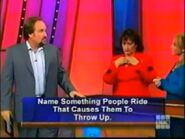
Question Reminder for Home Viewers (Karn version just) It was used on Karn's final yr of hosting.
For the first four seasons of the current syndicated run (1999–2003), there was no goal: the team with the most points won the game, although about families in this menstruum nevertheless scored over 300 points. As well, in that location was only one Strike immune for the controlling team in the Triple round (Round iv). This created the possibility that a team could give an incorrect answer and notwithstanding win if there were non plenty points in the depository financial institution for the other team to win by a successful steal. Other times, when an opposing family unit already had more points than the depository financial institution and the bank was lower than the amount of their atomic number 82, if the controlling family gave an incorrect answer, the game would automatically end.
Until the Bullseye format debuted in 1992, dollars were used instead of points (as Ray Combs explained at least in one case during the Bullseye era, the switch to points was because "the dollars are in your bank"). For whatever reason, the current syndicated run has continued to use points, which has been seen by some fans every bit a cost-cut measure.
Starting time in the sixth season of the Harvey version, losing teams receive $500 in the form of a Greenish Dot Prepaid Card (Greenish Dot is Harvey'due south endorsement).
Lollipop Tree (Dawson '76 version just) [ ]
Due to Dawson giving away boxes of lollipops (oftentimes Tootsie Roll Pops) to some of the studio audience members (particularly kids), a lollipop tree was introduced from March 2, 1983, all the way through June 14, 1985, where a tree of Tootsie pops was placed adjacent to the fifth histrion on each team. If he/she chose a lollipop with a black stem on the bottom, the family unit won a $100 bonus, which did not affect the outcome of the game.
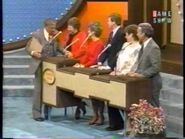
The lollipop tree is shown in an episode next to the family's podium. Yummy! I'd sure love some lollipops!
Lollipop Tree Knockdown [ ]
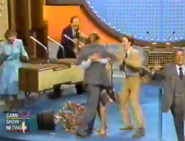
Whoa, this family unit historic so crazily that they knocked over the lollipop tree!
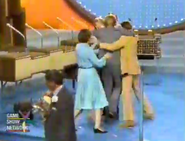
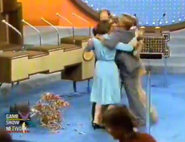
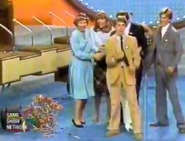
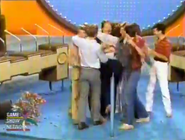
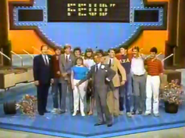
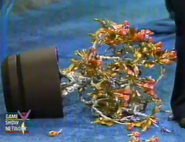
Whoops!
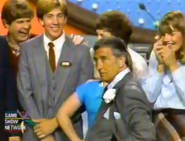
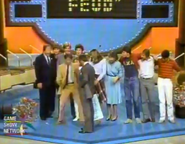
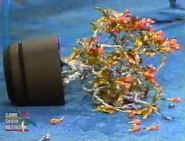
Cleanup on the stage floor!
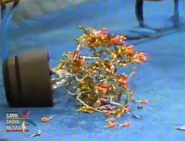
Additional NOTES: Originally, just one lollipop in each tree had a blackness stalk, merely inside weeks, there were ten on both copse.
In the 1985 finale, when a family member failed to go a lollipop with a dorsum stalk, Dawson used a black marker coloring the bottom black, and the family yet got a $100 bonus regardless.
Bullseye/Bankroll Round & Sudden Death Question [ ]
Starting in 1992, Family Feud instituted a new Bullseye circular. This was the round that affected the yard prize for either family if and when they make information technology to Fast Coin. In the pilot round during the start half, both families started with a bankroll of $2,000. Each family fellow member would get one question in an endeavour to build their family unit's banks. Giving the Bullseye answer (the number one answer) added $ane,000 to the bank for a possible full of $seven,000. In the 2d half of the 1992 pilot later three normal questions, each family fellow member over again got 1 question in an attempt to build their family'due south banks even higher. Giving the Bullseye answer (the number one answer) added $three,000 to the banking concern and the family with the most money would become to play for that money in Fast Coin. In the series circular, both families started with a bankroll of $5,000 ($2,500 in the first one-half of the Family Feud Challenge). Five questions were asked to each pair of family members in a Face-Off fashion, and merely the number ane answers counted. The first player to fizz-in with the number one answer added coin to their Fast Money bank; this resulted in a possible $ten,000 in the first half or $twenty,000 in the second half. The syndicated version used this circular from 1992 to 1994, with the doubled values.
In 1994 when the original host Richard Dawson returned, "Bullseye" was renamed "Backing". Plus the number of questions was reduced to three (worth $500, $ane,500 & $2,500 in the commencement half [$1,000, $3,000 & $five,000 in the second half] respectively), and only one member of each family played throughout the entire round. This resulted in a possible $7,000 in the first half or $fourteen,000 in the 2d half.
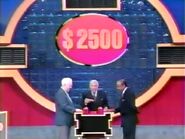
The Bankroll round is in session. From 1994 to 1995.
In 2009, the Bullseye round made a one-flavour render in the 11th season of the current version; both families started at $15,000, for a maximum of $xxx,000.
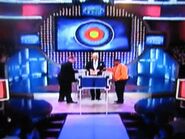
The Bullseye round is back and is in session. Introduced from 2009 to 2010.
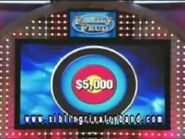
In this version, the Bullseye round was sponsored by The Sibling Rivalry Ring'south website.
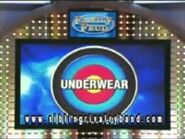
Hither'south the answer to ane of the questions.
Scoring [ ]
The questions and amounts for the 1992–1993 CBS daytime version were equally follows:
| Questions | 1st Half | 2nd One-half |
|---|---|---|
| Question 1 | $500 | $one,000 |
| Question 2 | $1,000 | $2,000 |
| Question 3 | $one,500 | $three,000 |
| Question 4 | $2,000 | $4,000 |
| Question 5 | $2,500 | $5,000 |
In the first half, each money amount increased in increments of $500, and in the 2nd half, each money amount increased in increments of $1,000.
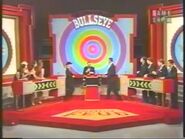
The Bullseye round is now in session. From the 1990s.
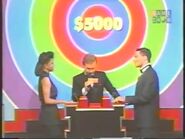
The questioned amount is $five,000.
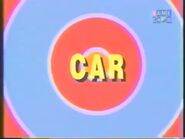
BULLSEYE!!!
The questions and amounts for the Syndicated 1992–1994 version were as follows:
| Questions | Amounts |
|---|---|
| Question 1 | $i,000 |
| Question two | $2,000 |
| Question 3 | $3,000 |
| Question 4 | $iv,000 |
| Question v | $5,000 |
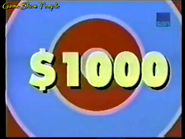
A $one,000 bullseye doesn't sound bad to me.
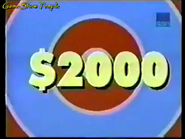
$2,000 for a bullseye seems skillful too.
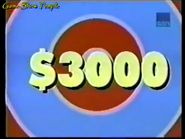
$three,000 is good as well.
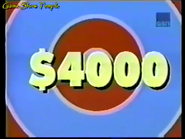
$iv,000 is squeamish.
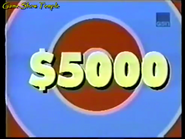
Only $5,000 is even better!
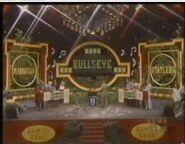
Hither's the Bullseye round from the Opryland specials.
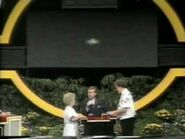
The question value amount is worth...
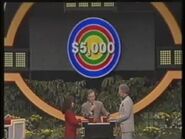
...$5,000!
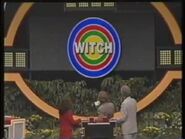
Hither's the Bullseye answer.
The questions and amounts for the Backing game were as follows:
| Questions | 1st One-half | 2d One-half |
|---|---|---|
| Question one | $500 | $1,000 |
| Question 2 | $1,500 | $3,000 |
| Question 3 | $two,500 | $five,000 |
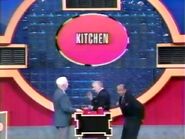
This was the respond to a Bankroll question.
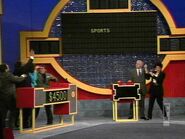
Here's what the studio audience sees in Bankroll.
The questions and amounts for the 2009–2010 syndicated version were as follows:
| Questions | Amounts |
|---|---|
| Question 1 | $1,000 |
| Question 2 | $ii,000 |
| Question iii | $iii,000 |
| Question 4 | $iv,000 |
| Question five | $v,000 |
Starting in 2003, a new Sudden Expiry tiebreaker was added. If neither family reaches 300 points after four questions, the fifth and final question is played as Sudden Death. It is played the same as the Bullseye/Bankroll questions. The final 2 players play one final Face-off and the first player to buzz-in with the number i answer earns triple value and wins the game. When the Bullseye round was re-instituted, the Sudden Death question was played after three questions, pregnant the fourth players played this question.
Though it never happened in the "one-strike Triple round" era (Anderson and Karn Season 1), the Sudden Decease question would be used in the effect of a tie after the said question, hence why it was chosen a "tiebreaker". If neither player gives the number one reply, they volition try again with a different question.
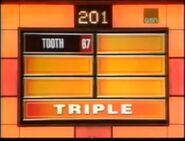
This one was introduced nether Karn's tenure between 2003-2005.

A sample of a Sudden Death layout between 2008-2010.
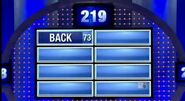
A sample of a Sudden Death during the Harvey era.
Bonus Round: Fast Coin [ ]
The winning family unit goes on to play Fast Money for a grand greenbacks prize. The winning family chooses which two players will play the game. The first family member stands at middle stage while the second family fellow member goes off stage to a soundproof area. The showtime thespian has 15 seconds (20 later on 1994) to respond five Family Feud questions. He/she has to give the almost popular answer to each question. He/she can pass on a question if stumped and return to it if there's time left. When he/she is done, the answers are revealed on a different board followed by the number of people who gave them. Subsequently all the answers are revealed and scored, the second player comes out and takes his/her turn. The 2d actor has xx seconds (25 later on 1994) to answer the same five questions only with 1 exception: he/she cannot repeat whatsoever of the answers previously given by the first player (classified as a "duplication") or a double buzzer volition sound, at which signal the host says, "Try again." The contestant must and so give a unlike answer (the second player will too be charged for similar answers or an answer which fits into the same category as the first player's answer). When the 2nd player is done, his/her answers are revealed and scored. The family wins $five for each point made in the round ($10 in the Combs pilots), only if the 2 playing players reach 200 points or more, the family wins the grand cash prize.
[ ]
- The first contestant from the winning family playing Fast Money would get 200 points and win the large money all by himself/herself. During Ray Combs' tenure, whenever that occurred, he would fob the 2d player into thinking that the kickoff player did terribly and so ask him/her five phony ridiculous questions. There has never been a contestant to get 200 points past himself/herself in the electric current incarnation.
- For the first four years of the render of the 300-betoken-goal in the current incarnation and on rare occasions, a squad would win the game by getting to 300 with only three questions. Whenever that happened, there would be a commercial suspension in between halves of Fast Coin. More than information in the trivia section.
- The original fourth dimension limits (15/20) were also used in the British version of Feud called Family Fortunes in their version of the Fast Money round, called the Big Money game/round.
- In the 1994 era, some Fast Coin answers were marked with asterisks, which meant that the answer was included in a broader answer. (i.e. the answer "charcoal-broil" would exist included in all food)
Grand Cash Prizes [ ]
The grand cash prizes are dissimilar depending on the series:
- Daytime Versions (1976–1985, 1988–1992) – $5,000
- All-Star Version (1978–1984) – first two games – $5,000/third game – $10,000
- Syndicated Versions (1977–1985, 1988–1992, 1999–2001) – $10,000
- Current Version (2001–2009, 2010–present) – $20,000
- CBS Gameshow Marathon Version (2006) – $100,000 for the player's charity (main game win), $50,000 for a home viewer (Fast Money win)
- NBC Glory Version (2008) – $l,000 for a win, $25,000 for a loss (both for charity)
- ABC Glory Version (2015-present) – $25,000 for a win, $10,000 for a loss (both for clemency)
- Steve Harvey's 1000th Family Feud (2016) – $fifty,000
Bullseye/Bankroll [ ]
Here are the max values in terms of Bullseye/Bankroll money:
- Combs Version (1992-1994)
- 1st Half – $10,000
- 2nd Half/Syndicated (1992-1994) – $20,000
- Dawson Version (1994-1995)
- 1st Half – $seven,000
- 2nd One-half – $fourteen,000
- O'Hurley Version (2009-2010) – $30,000
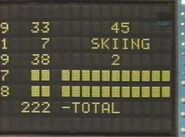
In Fast Money, Peter Marshall & Leslie Uggams win $x,000 for charity.
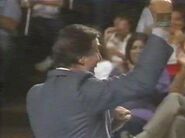
Peter celebrates his big victory!
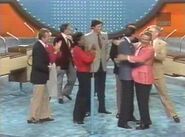
The Heavenly Hosts celebrate their big win with the Magnificent Thousand.C.s.
Returning Champions [ ]
On the ABC run, families retired from the show after winning over $25,000, a limit which had been lifted during the last season to $30,000. On the syndicated series from 1977 to 1985 and from 1999 to 2002, two new families competed on each evidence. From 1988 to 1992 and from 2002 onward, winning families could return for upwards to v days. From 1992 to 1995, families merely connected until defeated. Starting in September 2009, families who win five days in a row win a brand new car:
2009-2010: Chrysler 300C
2010-2012: Ford Taurus (blue for 2010-2011; red for 2011-2012)
2012-2013 and 2015-2016: Ford Edge
2013-2014: Ford Fusion
2014-2015: Ford Fusion Hybrid
2016-2017: Jeep Renegade
2017-2018 and 2019-2020: Jeep Cherokee Latitude
2018-2019: Toyota C-60 minutes
2020-2021: Jeep Cherokee Trailhawk
2021-2022: Jeep Compass
The Uproar/Family unit Circle Survey (Anderson era only) [ ]
When going into the 1st commercial suspension under Louie Anderson'south tenure, the viewers at home were asked an Uproar/Family Circle survey. At the end of the 1st commercial break, the respond(due south) were revealed.
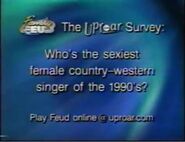
Try to respond this survey question!
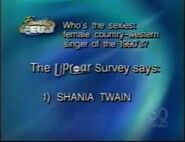
Man, she feels similar a woman! Shania Twain is the number one respond!
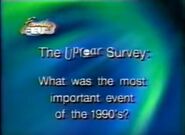
How about this i?
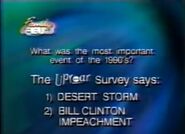
Hither's what the Uproar survey says!
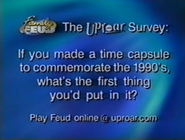
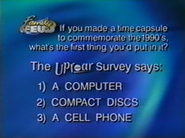
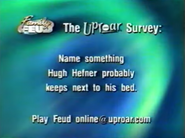
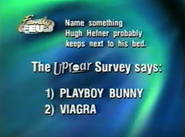
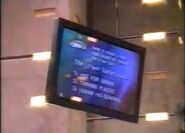
After the question was shown, the screen transitioned back to the primary set where the question was shown on the monitor, like this ane. Then, the family's name was changed dorsum as the camera panned to the center or side of the ready.
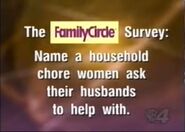
Afterward, Family Circle replaced Uproar for sponsorship of the survey. But still, try to answer this i if you tin can!
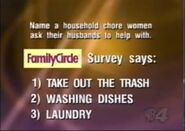
Here'south what the survey said!
Dumb Answer of the Day (Anderson era Simply) [ ]
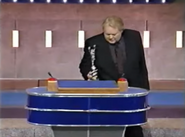
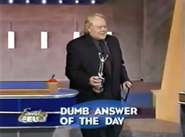
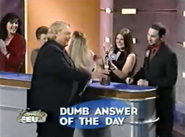
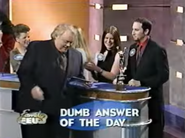
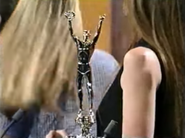
Information technology'south nice to get an award, fifty-fifty if it'southward a impaired respond.
1992 Bullseye Airplane pilot (Combs version Just) [ ]
In 1992, a pilot was shot for the Family unit Feud Challenge format, simply with a drastically dissimilar format.
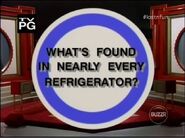
Can you figure this bullseye out?
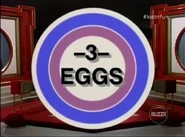
This is the Number 3 Answer.
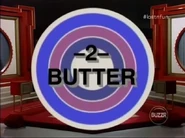
This is the Number ii Answer.
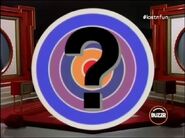
What is the Number ane Answer?
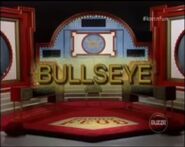
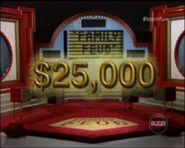
Wow, $25,000! Ooh, baby, that'south what I like!
Kickoff Half [ ]
In the outset half, each family was staked with $two,000. Each family member was asked a question. The #ane was worth $one,000, while #ii was $500 and #3 was $250, for a maximum of $seven,000. So, standard Feud was played (Single/Double/Triple, 300 wins), followed by Fast Money.
Screenshots [ ]

The board for the first half.
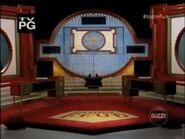
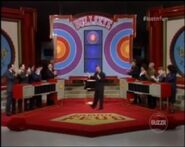
Here'south Ray welcoming the teams to the Family Feud Claiming!
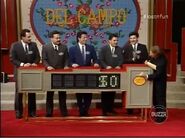
The family e'er starts at $0…
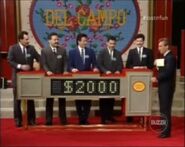
…and then, BAM! At that place's $2,000.
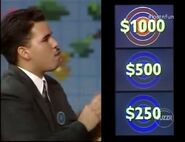
Is his answer the bullseye for $1,000?
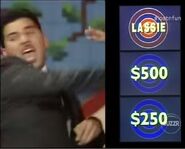
YES! LASSIE IS THE BULLSEYE!
Second One-half [ ]
The second one-half started with standard Feud against returning champions, but instead of a depository financial institution built for one family, the bank was instead multiplied past $10, then $20, and finally $30. Whichever family won the round added that coin to their Fast Coin bank. Also, the "steal answer adds to the depository financial institution" rule was used here.
Screenshots [ ]
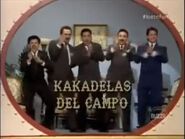
Information technology's the Del Campo Family unit vs. The Kakadelas Family unit!
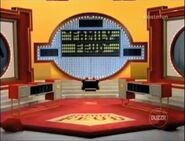
We're ready to go!
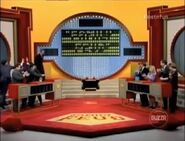
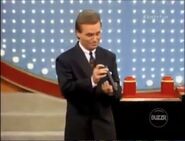
Whoops, looks similar Ray's microphone broke.
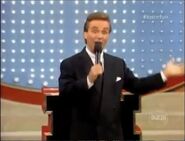
Regardless, he yet welcomes anybody to the Feud!
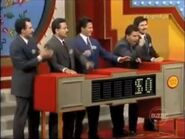
The Del Campos wait ready and raring to go! Hence, their rowdy mental attitude.
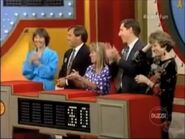
The Kakadelas' are ready to go too!
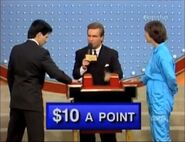
On the Bullseye versions, nosotros see a blue box that says how much the question is worth, such every bit this question for $10 a indicate.
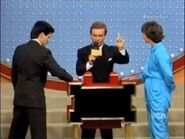
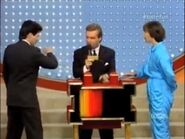
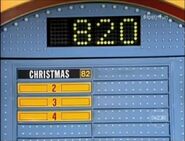
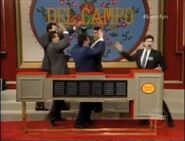
Wow, the Del Campos are goin' loco!
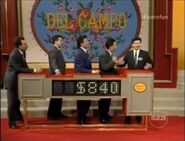
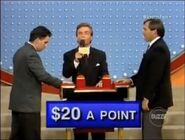
Stakes are getting higher! Allow's see who'll get this one!
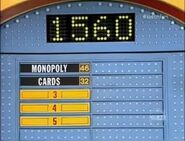
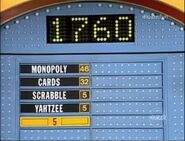
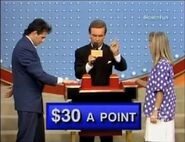
Triple it upward!
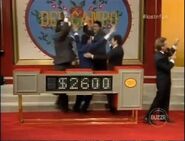
Some other round win for the Del Campos!
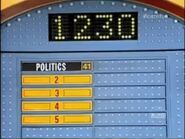
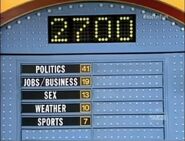
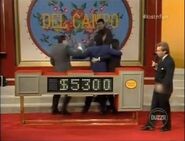
And only like that, the Del Campos won the game!
Some other round of Bullseye was then played; this time the Bullseye respond was worth $3,000 for a maximum of $15,000. Only the #1 answers were immune here. Whichever family had the higher depository financial institution at the end of this circular played Fast Money for that banking concern.
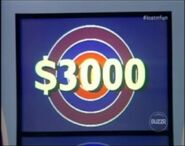
A $3,000 Bullseye! Stakes are getting high!
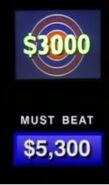
However, the contestant must trounce $5,300.
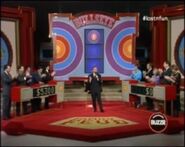
Time for the second half of the Bullseye!
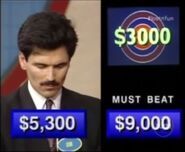
I hope his answer puts them closer to a win!
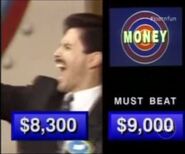
HE GOT IT!
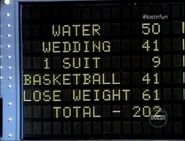
Amazing! This contestant broke 200 on their ain.
Boosted NOTES:
- The cue for when the Bullseye gear up came down in the pilot was recycled from the brusque-lived 1990-91 ABC revival of Match Game for when the "Star Bicycle" came down in utilise for the bonus circular.
- While the 4-digit bank display was carried over into the Family Feud Challenge series, The pilot'due south second half format did not, hence why the leftmost position was never used.
- In the Buzzr broadcast, the contestant tryout telephone numbers for San Diego and Los Angeles respectively (as you can see on the lesser of this screenshot hither) are blurred out which indicates that they are not "active" anymore. Also, not even New Yorkers could try out.
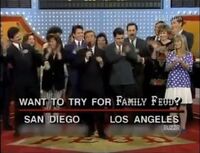
- Although you lot hear Gene Forest say the line "Some contestants will receive…" fee plugs were oddly never aired during the cease credits of the pilot, equally you only run into Ray and the families clapping and talking.
- 23 years later, this never-before-seen pilot aired on Buzzr as part of their special "Lost & Institute Calendar week" on September 8, 2015.
All-Star/Gameshow Marathon/Celebrity Family unit Feud primetime specials [ ]
In all versions of the All-Star/Glory primetime specials, four celebrity teams (celebrities and their families also in the Al Roker version) competed to win money for their favorite charities.
In the Richard Dawson all-star series, in that location were three games a evidence. The starting time ii games were played to $200 for a gamble at $5,000, while the third one was a ane-question showdown for a adventure at $10,000.
In the Ricki Lake Gameshow Marathon episode, finalists Kathy Najimy and Brande Roderick along with their families respectively competed to score 300 points commencement just like the noncombatant version. The points doubled in round four and tripled in round five and so on. The winning family won $100,000 for the charity of their choice. Fast Coin was played with the 20/25 second time limits, and winning earned a domicile viewer $50,000.
NOTE:
- Kathy Najimy was the winner of the episode and the whole series in general.
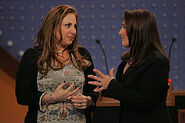
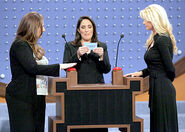
It'southward Kathy Najimy vs. Brande Roderick.
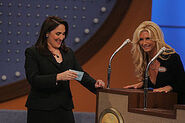
Celebrity Family unit Feud fabricated its debut on NBC as part of their "All-American Summer" cake on June 24, 2008, and concluded on July 29, 2008, hosted past Al Roker of The Today Show with Burton Richardson handling the announcing duties. In this version, there were besides three games, played single-single-triple, with the winning teams from the starting time two games playing the third for a chance at $50,000. In Fast Money, less than 200 points were worth $25,000. Families that lost received $10,000 for their charity.
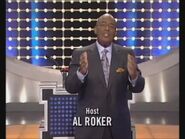
The host's proper noun appeared on the bottom of the screen from Celebrity Family Feud.
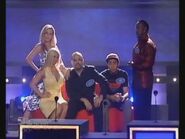
Ice-T'south family is ready for action!
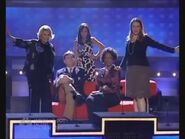
Joan Rivers and company is all set to play! Nosotros miss yous though, Joan.
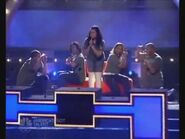
The Symone family is ready too!
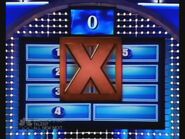
This volition signify that the player who buzzed in gave an respond that didn't match the survey.
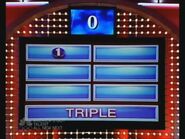
Those graphics & some gear up pieces were later carried over to the syndicated O'Hurley version.
Glory Family unit Feud made its comeback on ABC and premiered on June 21, 2015. This time, it was hosted by current Family unit Feud host Steve Harvey with Burton Richardson returning as the journalist. Unlike the previous version, 2 games are played separately, with the losing glory teams receiving a donation for the charity of their choice. Winning Fast Money is worth $25,000 while losing is worth $10,000.
Tournament of Champions [ ]
1988–1994 [ ]
The 1988–1994 version carried special tournaments for the four highest winning families from certain periods returning for a Winner-Take-All Tournament of Champions. These were rarely held at first for both the CBS and syndicated versions.
The main game rules applied, but if a family reached 200 points in Fast Money, $5,000 went into a jackpot that started at $25,000 and went up to potentially $55,000 on the CBS version. Besides, on the syndicated version, the jackpot started at $50,000 and went up to $x,000 for each fourth dimension Fast Coin was won, up to a possible $110,000. If the score was less than 200, null was added to the jackpot, as the $5 a signal rule was discarded for the tournament. Each semifinal was the best-of-three games, with the first family unit in each one to win two games advancing to the finals, which was also a all-time-of-three friction match. There was no Fast Coin round played during the finals. The scoring was like to the 1984–1985 season (single-single-unmarried-single-double-triple) or the regular CBS/Syndicated version from late 1989 to 1990 (single-single-single-double-triple) in the finals, with the first family to attain $400 winning the game instead of $300. The first family to win ii out of three games won everything in the jackpot in addition to what they won in the regular game. Once again, no Fast Money was played.
No boosted tournaments were conducted on the syndicated version later on the 2nd season. The CBS version continued conducting them, but in mid-1990, tournaments were held every month, with the height four coin-winning families of the previous month returning. The main game point goals for winning a semifinal and a final game were the same, but the match format was changed from the best-of-three to a 1-game lucifer for both the semifinals and the finals. Thus, the potential maximum was lowered to $35,000.
2002–Present [ ]
The current version began doing tournaments in 2002. The first occurred in February 2002 with the Family Circle Tournament of Champions, with eight winning families returning in a unmarried-emptying tournament. The jackpot started at $50,000 and went up to $20,000 for each time Fast Money was won, up to a possible $170,000. For this item tournament simply, if Fast Coin was not won, $v per indicate was added to the jackpot. Each game was played to 300 points except for the finals, which required 500 points to win the game and the jackpot. The winning team for this tournament won a trip to Charleston, Southward Carolina and tickets to the Family Circle Loving cup women'south lawn tennis tournament in nearby Daniel Island, in addition to the money, which was $112,230. The runners-up for this tournament won a trip to Jamaica. Likewise, for the finals only, the double round was used, despite the fact they were still using the "iii singles and one-strike triple round" format.
This version, withal, did not do tournaments on an occasional ground until May 2005. Again, eight families were brought back, merely this time, they consisted of either family unit who previously lost their get-go game for the tournament that was held in May 2005 and May 2006, or previously winning families, but not necessarily focusing on the higher winning families of the past for the tournament held in February 2006. The differences at this point for the tournaments were that the jackpot started with nil, except for the February 2006 Tournament of Champions, which began at $ten,000 and went upwardly to $20,000 for each time Fast Coin was won, up to a possible $130,000. Losses in Fast Coin did not add annihilation to the jackpot, equally in the 1988–1994 version, and the championship game was played to 400 points and used the 4 singles-double-triple round format (with Sudden Death if applicative). Trips were sometimes awarded to the jackpot-winning family, including Hawaii during the February 2006 tournament and Mexico during the May 2006 tournament. Once again, no Fast Money was played in the finals.
The tournament format did not return until 2013, where the jackpot started at $forty,000 and could get as loftier as $160,000 and was sponsored past Publishers Immigration Firm. The Fast Money round was won 6 times in a row and had it built up to $160,000. Every bit before, in that location was no Fast Money circular in the finals, and the get-go team to reach 400 points won the jackpot of $160,000 and the runners-up received $20,000.
Galleries [ ]
To come across pictures of the many looks of the Family Feud logos over the years click here.
To see pictures of the many sets of the Family Feud over the years click here.
To run across pictures of testify tickets click here.
To come across videos of Family unit Feud click here.
Additional Pages [ ]
Family unit Feud/Merchandise
Family Feud/Charity Specials
Family unit Feud/The Feud In Pop Culture
Family unit Feud/Airdates
Family Feud/Quotes & Catchphrases
Family Feud/Celebrity Family unit Feud Gallery
Sounds [ ]
The strike buzzer, the correct answer clang, and the win bells were recycled from a previous ABC Goodson-Todman game prove, Showoffs.
The Face-Off buzzer sound was used in a few other Goodson-Todman shows such as:
- Child'south Play
- Classic Concentration
- Trivia Trap
- Chuck Henry'due south Now You See It
Spin-Offs [ ]
Lucifer Game – (every bit mentioned above) the bonus round "Super Match" inspired this show.
All-Star Family Feud Special – the original nighttime 60 minutes-long special series where celebrities (normally from popular Tv shows) competed for their favorite charities. The series aired on ABC from 1978 until 1985.
The Family unit Feud Challenge – the short-lived, hr-long daytime version where it incorporated the Bullseye round format. It aired on CBS from 1992 until 1993.
The New Family Feud – the curt-lived, half-hour syndicated version where it also incorporated the Bullseye round format. It aired in syndication from 1992 until 1994.
The E! True Hollywood Story: Family Feud – A special-like documentary episode virtually the history of the show along with its first three hosts (Richard Dawson, Ray Combs, and Louie Anderson respectively) that aired on the East! Network on July 28, 2002.
Gameshow Marathon – In 2006, Family Feud was the finale of the 7 games.
¿Que Die la Gente? – The short-lived, Castilian-language U.Due south. original that aired on TeleFutura from 2006 until 2008.
Celebrity Family unit Feud – A dark 60 minutes-long six-episode summer series (similar to the primetime All-Star specials during the Dawson ABC era) that aired on NBC in 2008 with teams of celebrities playing for clemency. All but ane episode aired. The new graphics and music this show had were incorporated into the current syndicated version until 2010. The series was and so afterward rebooted on ABC in 2015 where information technology plays very similar to the current syndicated version.
Philly Pheud – Like spinoff airing in Philadelphia airing locally on WPHL MNT 17 since 2013.
100 Latinos Dijeron – The Castilian linguistic communication U.S. reboot, that aired on MundoMax (formerly MundoFOX) from 2013 until 2016.
Family Feud (Buzzr) – The online version of the testify that features various net celebrities as contestants, airing on YouTube since 2014.
Inventors [ ]
Mark Goodson & Pecker Todman
Music [ ]
Principal Cues [ ]
1975, 1976–1985, 2006 – "The Feud" by Walt Levinsky, Robert A. Israel & Ken Bichel
1988-1994, 1992 Pilot, 2002-2003, 2008–Nowadays – remake of "The Feud" by Edd Kalehoff & Score Productions
1994-1995 – Edd Kalehoff & Score Productions
1999–2006 – John Lewis Parker
2003 (Unused) – John Lewis Parker, based on the 1988 theme past Edd Kalehoff
2006-2008 – John Lewis Parker
1976's main theme was originally a prize cue past Walt Levinsky on The Price is Right and when Mark Goodson heard information technology, it inspired him to create this testify.
The last few notes of the 1976 theme are currently beingness used on The Toll is Right every bit the introduction to Grand Game; they were as well used for the intro to Plinko's first playing. Trivia Trap as well used these notes for getting all the incorrect answers eliminated. For a brief time in the 1990s, the 1988 theme's endnotes replaced those from the 1976 theme in the aforementioned M Game introduction. When the game prop was redone in 2013, the concluding drum annotation at the terminate was removed from the 1976 ending theme.
The 1994 opening vamps, as well as the unused main themes from the 1994 version, were recycled into the daytime and 1994 versions of The Toll is Right as showcase cues.
Although 2003's main theme was unused, replaced with 1988'south master theme, the face up-off cue was nonetheless used on the show.
From 1999 to 2006, the main theme song had a hip-hop music style that used electric guitars or saxophones.
For early on 2003, the original 1988 version theme was brought back for the primary, despite two updated mixes of the theme being made, as well every bit the 1988 fiddle/electric guitar face-off cue played when the chief game is won. But the face up-off cue from the 2003 package is used.
For Disco Calendar week, a disco remix of the 1999 theme was used based on "You Should Be Dancing" by the Bee Gees. The 1988 theme was dropped afterward and the 1999 theme package was reinstated.
From 2006 to 2008, the chief theme song had a remix of the hip-hop music style with a disco music style. The winning cues were recycled from 2002 to 2006.
From 2008 to nowadays, 1988'southward main theme was brought back again and is the merely cue used on the show.
Special Cues [ ]
1988
- Beauties vs Beasts Special Open – "Olympic Fanfare" by Al Capps (Killer Tracks)
- NWA Wrestlers vs GLOW Wrestlers Special Open up – "The Solitary Bull" by Herb Alpert
- Miss USA vs Miss Universe Special Open - "Vogue" past Madonna
- The Toll Is Correct vs The Young and the Restless Open – "Walking" by Score Productions (too known as the "come up on downwardly" cue from Price)
- Christmas-themed Family Feud Challenge open up - "Sleigh Ride" by the Boston Pops
1992 Pilot
- On the 1992 Family unit Feud Challenge airplane pilot, the cue from the 1990 version of Match Game when the Star Wheel was revealed by Score Productions was used when the Bullseye set lowered onto the stage.
1999
- Armed Forces Week Special Open – "Stars and Stripes Forever" by the United States Marine Corps
- Disco Week Special Main – by John Lewis Parker, based on "You lot Should Exist Dancing" by the Bee Gees
- Disco Week Ending – "YMCA" by the Village People
- NASCAR week Special Face-Off – "Thunder" by David Robidoux
Studios [ ]
ABC Telly Centre, Hollywood, California
CBS Television City, Hollywood, California (Celebrity Family Feud [ABC Summer Fun & Games]) (2017)
NBC Studios, Burbank, California (Now the Burbank Studios)
Tribune Studios (At present the Sunset Bronson Studios)
Universal Studios Florida
Atlanta Civic Centre
Georgia Earth Congress Centre
Universal Studios Hollywood
Sony Pictures Studios (Celebrity Family Feud [ABC Summer Fun & Games]) (2016)
Los Angeles Center Studios (2017–Present)
1-900-230-FEUD (1989) [ ]
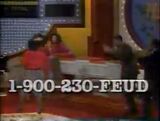
In 1989, there was a short-lived, 1-900 number game called "1-900-230-FEUD" where y'all can "Play Family unit Feud at Habitation!" xx-iv hours a day and win valuable prizes including a U.S. savings bail, a color Boob tube, CD players and a trip to Los Angeles, CA as a guest of Family Feud. Some prizes were provided by Sharp Electronics while each phone call was $ane.50 a infinitesimal and 75 cents for each additional infinitesimal. The commercial itself featured the late Ray Combs promoting the game.
1997 Proposal [ ]
A revival of the show (along with Dawson again as the host) was planned at the time. All the same, it fell through at the concluding minute.
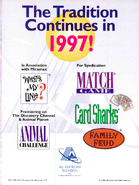
Family Feud Live! [ ]
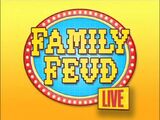
Family Feud Live! is a phase testify originally held at the Foxwoods Resorts & Casino in Connecticut with several hosts, including Michael Burger, Marc Summers, Doug Davidson, David Ruprecht, and Bob Goen. The shows are produced in association with RTL group officials, including erstwhile television director Andrew Felsher, producer Cathy Dawson and others who accept worked on the TV version of the Feud and other popular Television receiver game shows. (NOTE: The live phase version ran at two casinos in Atlantic City in 2006.) In 2013, a touring version of the show plays by and large in county fairs from the U.S. and Canada, including the Calgary Stampede in Calgary, Canada. Actress, comedienne, former talk show host, and idiot box personality Caroline Rhea currently hosts this edition, making her the first woman to host an official iteration of the classic game prove.
The gear up by and large resembles the 1988-94 Combs era while the format mostly emulates from the Telly show itself, except with two sets of contestants (normally unrelated audition members) going through the master portion of the game. Following this, two additional audience members play the Fast Coin round. Also, various video footage of funny moments from the show'due south rich history along with a cursory history of the show itself is shown.
Additional Notes:
- There are four team members instead of five (a la 1994-95 Dawson 2.0 era).
- There's no Bullseye Circular/Bankroll Game.
Promo [ ]

In 2019, a new "Celebrity Edition" of the Live show was announced for appearances around the state from May 31-June 14, 2019. This version was hosted by comedian Alonzo Bodden and featured glory team captains Brian Baumgartner, Cathy Rigby and "Grocery Store Joe" Amabile.[i]
Buzzr Version [ ]
Since 2014, a YouTube channel called Buzzr[2] has an online version of Family Feud featuring diverse YouTube celebrities as contestants, originally hosted by Josh Leyva followed by Adam Lustick.
International Versions [ ]
The following countries that did their versions of Family Feud include:
- Afghanistan
- People's democratic republic of algeria
- Argentina
- Armenia
- Australia
- Azerbaijan
- Belgium (Dutch language simply)
- Brazil
- Republic of bulgaria
- Canada (French language merely, currently ambulation on Five) (The American version currently airing on Metropolis Goggle box) (The Canadian version currently airing on CBC)
- Chile
- China
- Colombia
- Croatia
- Cyprus
- The Czech republic
- Estonia
- Finland
- French republic
- Germany
- Ghana
- Hellenic republic
- Hong Kong
- Hungary
- India
- Republic of indonesia
- Republic of ireland
- State of israel
- Italy
- Japan
- Jordan
- Kazakhstan
- Lebanon
- Lithuania
- Luxembourg
- Malaysia
- Mexico
- Moldova
- Mongolia
- Myanmar
- Netherlands
- New Zealand
- Nicaragua
- Kingdom of norway
- Panama
- Republic of peru
- Philippines
- Poland
- Portugal
- Romania
- Russia
- Serbia
- Slovakia
- Slovenia
- S Africa
- Espana
- Sweden
- Switzerland
- Taiwan
- Thailand
- Tunisia
- Turkey
- Ukraine
- The United Arab Emirates
- U.k. (Family Fortunes)
- Uruguay
- Venezuela
- Vietnam
Boosted Notes [ ]
- Some versions use the 4 vs. four squad member format (i.due east. Australia, Philippines, and Thailand). Before this, the short-lived Dawson '94 version in America had also used the four vs. 4 formats.
- Some versions take included the "Bullseye" round format (i.east. Portugal ['93 version], Republic of indonesia and Australia ['06 version]).
- Some versions have logos based on the United kingdom version called All-Star Family Fortunes (i.e. Ireland and Indonesia ['09 and '13 versions]).
- Some versions use 2 female administration/models to help the second player to the soundproof booth during the Fast Money round (i.e. Mexico and Australia ['06 version]). Before this, the U.Southward. Spanish-language versions had also used two female assistants as well (i.due east. Qué Dice la Gente & 100 Latinos Dijeron).
- Some versions take been hosted by women instead of men (i.e. Venezuela, Kingdom of belgium [2002 version] and Slovenia [2007 version]).
- Some versions take been hosted by couples instead of individual hosts (i.e. Turkey [2010 version] and Vietnam [2015 version]).
- The brusk-lived 2012 Republic of cyprus remake/revival version called Fast Money! is a reference and pay homage to the bonus circular from the American version of the same proper name.
- In 2013, it was appear that the Brazilian network Rede Record was considered in reviving Family Feud with Rafael Cortez as host but plans fell through at the last minute.
- For the short-lived 2001 Spain remake of Vaya Pena (Get Rock) it was originally announced that Ana Garcia Obregon would be the host before she was later replaced past Carlos Lozano as he at the time hosted the Espana version of The Price is Right chosen El Precio Justo (The Right Cost).
- For the short-lived 2014 Belgian revival of Familieraad (Family Quango) it was originally appear that Sean D'Hondt would be the host before he was later replaced past comedian Chris Van den Durpel.
Trivia [ ]
- In 1975, before they changed the name (and much later the format) to Family Feud, the evidence was originally going to exist called Fast Visitor where 2 teams (1 celebrity and one civilian) competed to give correct answers to a question. The thought was kickoff pitched to NBC (then afterwards to ABC), but both networks were never sold on it. Then much later in its lifespan, the game format had to be tinkered with over again to employ survey questions for its final parts of the show.
- Before Feud, Richard Dawson's first game prove that he hosted was the locally-produced Lucky Pair (created by Bob Barker) from 1970 until 1971. Also, he hosted a revival of the 1950s panel game Masquerade Party (under the Hatos-Hall brand) running from 1974 until 1975. Before this, Dawson was a popular panelist on Match Game until 1978.
- The current "WOOSH!" sound issue for when an answer was revealed on the board was recycled from the short-lived 2001–2002 syndicated version of Carte du jour Sharks for when a red button was pushed to reveal the side by side card in sequence. The sound was originally used in O'Hurley's version and has been carried over since then.
- In the 2d and later rounds, Ray Combs would not say "Nosotros surveyed/asked 100 people" as he put the elevation number of answers up on the board. Richard Karn would often practise this too at the start of Round 2 until 2006. Since then, Steve Harvey would oft exercise this as well at the kickoff of Round i.
- When Richard Dawson, Ray Combs, Richard Karn, and John O'Hurley went to the controlling family later the confront-off question, they sometimes didn't use the give-and-take "Name" when request the same question to the family member.
- When Dawson and Combs started asking the 5 questions in the fast money round, they drop out the word "Proper noun" for the second through 5th questions. Richard Karn has washed that on some episodes during the fast money circular, too.
- Case: "Name something that has buttons", (player answers), "an animal that eats plants", (player gives the 2nd answer), "something specific that melts", (player gives the tertiary answer), "a sport that's played indoors", (histrion gives the fourth respond), "something you see in the summertime", (thespian gives the fifth respond). As well, this mode was done on the British version of Feud called Family Fortunes in their version of the Fast Money circular chosen The Large Money game/round.
- The famous "Bleep" sound effect from the Fast Money round when an answer was revealed on its Ferranti-Packard (1976-1995) and visually-styled (1999–Present) board made its debut in the 1988-1994 Combs version and has been used since then. Still, out of all the previous incarnations of the prove, it was never used in the original 1976-1985 Dawson version and the 2006 Gameshow Marathon episode.
- Additionally, the "Blip" sound consequence is also used when someone buzzes in on the Celebrity Jeopardy! parodies on Saturday Nighttime Live.
- It was start used on Trivia Trap, to reveal the four choices to a question.
- The famous "Ring-In" sound event from the "Confront-Off" was also borrowed on other various game shows including:
- Child's Play
- Archetype Concentration
- On a Ringlet (1986 Pilot)
- The Last Give-and-take
- The CNN Quiz Show: Presidents Edition; The Seventies Edition, Television receiver Edition & Famous Americans Edition
- The sound issue from the "Fast Money" round for which has been used in other previous versions since the Combs version from 1988 was originally from the curt-lived Trivia Trap to reveal the iv choices to a question.
- The buttons on the "Face-Off" podium in the original 1976-1985 Dawson version were always colored yellow. They were never red until the 1988-1994 Combs version and all other incarnations since then. In the 2006 "Family Feud" episode of Gameshow Marathon, the buttons on the face-off podium were also colored blood-red. Also, when a player slapped the button on the face up-off podium, the light wiped in (similar to the rainbow wipe from 1988 to 1995) instead of repeatedly flashing.
- This is the second game show where John O'Hurley and Burton Richardson worked together from 2006 to 2010. The start game show on which they worked together was the curt-lived 2000–2002 revival of To Tell the Truth.
- Both the Combs and Dawson '94 versions of the bear witness were the only two incarnations of the franchise to nix The "Play or Pass/Laissez passer or Play" option for which afterwards a contestant in the Face-Off guessed the top reply, or if the opposing contestant guessed a better answer than the one before. His or her team was then forced to play the question out until they got 3 strikes. However, four years later, the "Play or Pass/Laissez passer or Play" option returned in the 1999–2002 version with Louie Anderson at the helm, and all other previous incarnations accept carried over since then.
- In the 1994–1995 Dawson version, the original squad size was reduced from five to four. The original size returned in the 1999–2002 Anderson version and all other incarnations have kept it since then.
- For the 1976 Dawson version, to boost the show's sagging ratings for both the ABC daytime and syndicated versions in the 1984–1985 flavor, they extended the number of points needed to win the game from 300 to 400 (with one more than round added to the main game). Sadly, the ratings for both versions were beingness hammered by the likes of The Cost is Correct on CBS and Scrabble on NBC. However, the 400-signal format later on returned in the "Tournament of Champions" finale (for which the Fast Coin round was excluded) of the Combs, Karn, O'Hurley and Harvey versions since and so.
- It takes at least three rounds to reach 300 points, but normally it took iv rounds to reach 300 points. In the final season of both original versions, it sometimes took seven rounds to attain 400 points.
- In 1998, famed country singer Dolly Parton was near selected to host the revival in 1998 before the job ultimately went to Louie Anderson in 1999.
- Fast Money got played early 4 times. It happened at least three times with Richard Karn and once with John O'Hurley and the three family teams that won at least 300 points in only 3 rounds won $20,000 in Fast Money.
- Later on the first run of Fast Money, Richard Karn would bring out the second Fast Money contestant after the 4th commercial break while John O'Hurley brought out the second Fast Money contestant before the fourth commercial break. In both cases, viewers got to see the within of the isolation berth where the second contestant sabbatum earlier playing their turn. Viewers too got to encounter the headphones they had to wear, as well as a big Telly monitor displaying the show'southward logo. Also, when the second player was brought out, the camera would cut to an off-screen stagehand removing the headphones and the histrion rushing out from the berth.
- On most early on episodes until the original finale, earlier Fast Money was played, when the timer sets the clock, Richard Dawson would not say, "Clock will start later on I read this first question." Ray Combs ofttimes does this, too, sometimes until 1994. Steve Harvey frequently does this, also, at the start of the 2012–2013 season.
- During the 2009–2010 season, after the Bullseye circular was played, instead of O'Hurley asking to "introduce me to your family", the families would introduce themselves via video prune. The concept would stop since 2010.
- During the 2010–2011 season, before the first half of the Fast Money round started, a special video prune featured a random passer-by wishing the winning family the best of luck in Fast Money. This concept would stop since 2011.
- Despite the dissimilar years between them (i.eastward. 2002–2006 & 2006–2010), both Richard Karn and John O'Hurley are the only two hosts out of the 6 from the franchise (excluding Ricki Lake and Al Roker respectively) to share the same 4-twelvemonth but hosting tenures during their respective runs.
- The 2002–2005 Karn era Feud set was used for the unsold 2003 game show pilot called I'one thousand With Stupid hosted past Graham Norton. Also, the set up was used for the 2002 FOX special called TV's Funniest Game Shows hosted past Richard Karn.
- In 2008, John O'Hurley was not available to host NBC'south Celebrity Family Feud (hosted by Al Roker) every bit he was committed to hosting another network serial on CBS called Secret Talents Of The Stars which was a one-episode-just flop at the time.
- During O'Hurley's 4th and final flavor of the show, the Cunningham family was the first squad to win a make new car in 2009.
- The car gimmick is not carried over in the Fast Money round (i.due east. winning the auto after reaching 200 points) whether a family wins or loses on their fifth and final advent on the testify.
- Before the reboot of Celebrity Family Feud aired on ABC in 2015, Harvey's starting time (and concluding) show he starred in the same network at the time was the short-lived sitcom called Me and the Boys which ran from 1994 until 1995.
- Starting in September 2015, should a family win a car, but with at least ane reply unrevealed, the audience was enforced to still read out the remaining answers, as they didn't during the previous seasons.
- Both the Anderson and Karn versions respectively reran on PAX; later the O'Hurley version was rerun on Ion Tv.
- The show used to air on Canada'southward Superstation NTV until June 2014, and on CTS until September 2014, before information technology was renamed YesTV. It was besides rerun on GameTV (Canada's GSN) likewise from Harvey'due south 3rd and quaternary yr of hosting.
- Along with GSN, Harvey's version reran simultaneously on TV Land, BET, and its spinoff channel Centric.
- On Feb 21, 2017, the 1988–1994 theme of the show was used on Celebrity Name Game when Craig Ferguson said "I will be the clue giver."; both shows are endemic by FremantleMedia Northward America.
- On July 23, 2017, comedian and former Feud host Louie Anderson had competed on an episode of the ABC version of Celebrity Family Feud where his opponent was singer/actress Christina Milian.
- Sometimes, in the Harvey version of the Feud, at the beginning of Fast Money, Steve will not say any rules of Fast Money at all. Instead, afterward the final commercial break, the game board volition show the Fast Money lath, and the round volition begin immediately. When it's the 2d contestant's plow, Steve will remind the contestant how many points are needed to win the $20,000, and then the 2nd player's turn will begin immediately.
- Starting with the 2015–2016 flavour, the bell can be heard at the beginning and the winning families exclaiming they won the Fast Money Round while the closing credits roll.
- Starting with the 2021-22 season, once Fast Money ends, the show will immediately go to a brief one infinitesimal commercial break (showing the promotional consideration plugs). When the show returned from the interruption, Steve would recap the number one answers, announce the final full for the family and sign-off while the credits are rolling.
Age Requirements [ ]
When Richard Dawson hosted the show from 1976 to 1985, the minimum age to participate was xvi. This was lowered to fourteen when Ray Combs hosted the bear witness from 1988 to 1994. Ever since the show was revived in 1999, the minimum age to take role in the show is 16 over again.
Ratings [ ]
![]() Dawson and Combs versions
Dawson and Combs versions
![]() A few episodes of the Dawson version. This rating was permanently used on all versions since the Anderson era.
A few episodes of the Dawson version. This rating was permanently used on all versions since the Anderson era.
![]() (DLS) On The YouTube exclusive episodes Feud XXL.
(DLS) On The YouTube exclusive episodes Feud XXL.
Rebroadcasts [ ]
Game Show Network has aired the entire runs of the Dawson, Combs, Karn, O'Hurley and Harvey versions (though the latter has not been canceled, and then new leases are continuously acquired ordinarily on an annual ground). During a Thanksgiving marathon early in the 2010s, GSN aired 2 episodes of the Anderson version from 2000. Dawson's version aired in some form from the network'south starting time twenty-four hours on the air in December 1994 and aired for over nineteen years non-end before it left GSN in April 2013. Combs' version was aired on GSN during much of the 2000s, but starting in July 2006, that version got intermittently pulled off the schedule and put back on later on a while. This trend continued until April 2010, when that version left GSN and has non aired regularly since. Currently, but the Harvey version airs regularly on GSN.
Since the launch of Buzzr on June 1, 2015, the subchannel aired older Family unit Feud but started with some of the Dawson eras from 1980. The Combs' version was later added in Feb 2017, just the Dawson era was removed on January 14, 2019, after airing in the four a.thousand. ET slot for some months. Anderson's and Karn's versions aired for a brusque period, but currently do not air.
GameTV in Canada aired the syndicated Harvey version before in the 2010s merely no longer airs. Only the network started ambulation reruns of Glory Family Feud with Steve Harvey in December 2018. Since March 8, 2019, GameTV has been ambulation the Combs version in prime fourth dimension, equally part of its Friday night "Old and New" cake, where two back-to-back episodes of the CBS version are being aired, followed past the hour-long Celebrity Family Feud. On July two, 2019, Combs' version was moved to weekday afternoons, and since September 2019, two episodes aired dorsum-to-back per weekday.
On February 17, 2020, in honor of Family Twenty-four hours, a statutory vacation in much of Canada, GameTV aired a marathon of Family unit Feud, consisting of the Combs' version, Celebrity Family unit Feud with Steve Harvey, and also episodes from Richard Dawson's version. Information technology is uncertain at this indicate whether or non the Dawson version will air regularly.
References [ ]
- ↑ Official Site for 2019 Live Bear witness
- ↑ Family unit Feud | BUZZR
Links [ ]
Official Site
Fremantle Site
Official Site (Celebrity Version/Roker '08|via Internet Archive)
Official Site (Glory Version/Harvey 'xv)
Official Video Site (Celebrity Version/Harvey '15)
The "original" official website from the 1999-2002 era featuring pictures from the 2002 Karn era (via Cyberspace Archive)
The "original" official website for the 2002-2006 Karn era (via Cyberspace Archive)
Contestant Call sub-site (O'Hurley era/via Internet Archive)
The "original" official website for the 2006-2010 O'Hurley era (via Net Archive)
YouTube Contour
Kyle's Family unit Feud Dominion
Josh Rebich's Family unit Feud Rule Sheets
A gallery of the original 1976-1985 Dawson version
A gallery of the revised 1994-1995 Dawson version
Diet Dr. Pepper "CRIME FAMILY FEUD" TV Commercial by Young & Rubicam
Fast Money Spoof Promo for their "January Stand-Upwardly Month" in 2005 on Comedy Central
Official Pearson website for Family unit Feud (and Family Fortunes) via Internet Archives
Official Pearson website for Family unit Feud ('99-'02 Anderson era) via Internet Athenaeum
Family Feud's 400 Point Format
Family Feud's Bullseye Game
Ray Combs' Last Fast Money
YouTube Videos [ ]
Family Feud Live! [ ]
Official Website
Host Preparation Family unit Feud Alive!
Family Feud Live! Fairs
Family Feud Live! at the San Diego County Off-white promo
Rehearsal of Atlantic Urban center's Family Feud Live! 2006
Family Feud, Live! Highlights
Michael Burger Hosting Family Feud Alive!
Family Feud Live! Michael Burger clip
Family unit Feud Alive! Fast Money Roger Guild clip
Source: https://gameshows.fandom.com/wiki/Family_Feud
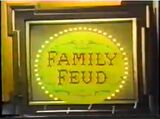
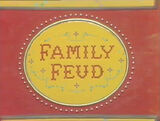
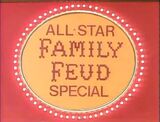

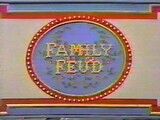
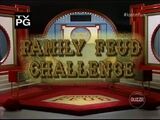
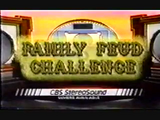
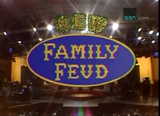
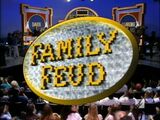
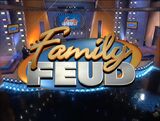
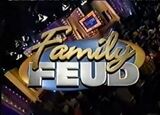
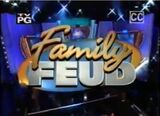
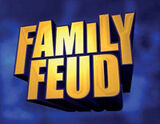
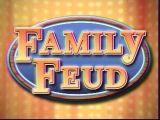
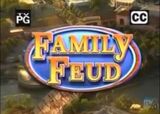

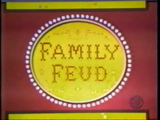
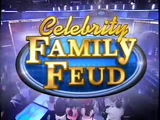
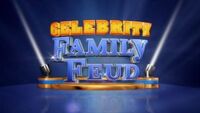
0 Response to "Family Feud 1st Fast Money 200 Points One Turn"
Post a Comment